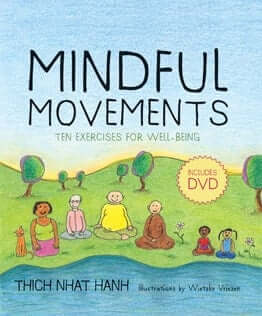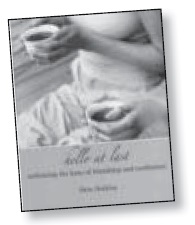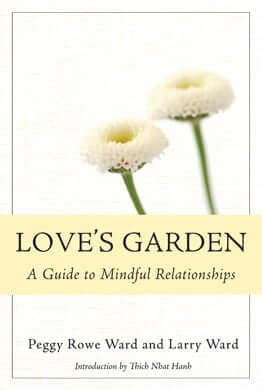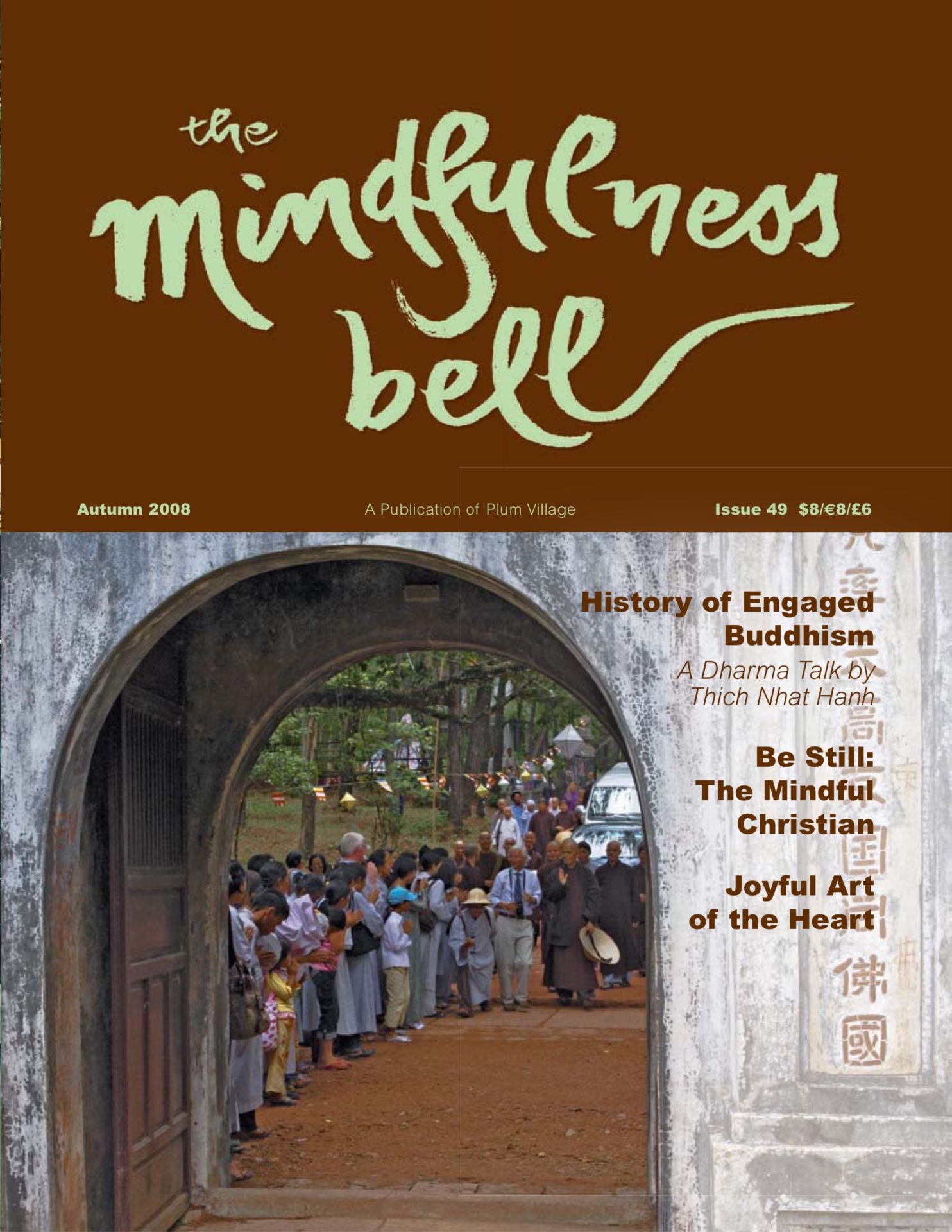
Mindful Movements:
Ten Exercises for Well-Being
Thich Nhat Hanh and Wietske Vriezen
Parallax Press, 2008
Hardcover, ringbound, 61 pages With DVD featuring Brother Michael, Thich Nhat Hanh, and monks and nuns of the Plum Village community, produced by Sounds True — 36 minutes
Reviewed by Judith Toy, True Door of Peace
What a joy,

Mindful Movements:
Ten Exercises for Well-Being
Thich Nhat Hanh and Wietske Vriezen
Parallax Press, 2008
Hardcover, ringbound, 61 pages With DVD featuring Brother Michael, Thich Nhat Hanh, and monks and nuns of the Plum Village community, produced by Sounds True — 36 minutes
Reviewed by Judith Toy, True Door of Peace
What a joy, this colorful new offering by Parallax! With its ringbound format, it lies open easily on a table or on the floor, so we can read what to do and see how to move. Thich Nhat Hanh developed these ten low-impact exercises as a comprehensive way to stretch between seated meditation sessions at his monastery. Like a simple, gentle yoga, they focus on the breath. Wietske Vriezen is a Dutch illustrator who has practiced with Thich Nhat Hanh; his full-color childlike illustrations appear on every page. A portion of the proceeds of every book sold goes to support nonprofit projects in Vietnam.
I’ve often enjoyed Thay’s ten mindful movements: outdoors while waiting for breakfast with the monks and nuns at Deer Park Monastery in Escondido, California; outside our “hermitage” with a Sangha of strangers in the sacred pre-dawn of the Rocky Mountains in Estes Park, Colorado; alone in our cottage in Black Mountain, North Carolina; in the zendo at a retreat at Southern Dharma Retreat Center in Hot Springs, North Carolina; and with my Dharma “family” in the bamboo grove in Plum Village’s Upper Hamlet. I bought this book for my ten-year-old granddaughter who plans a year-long peace project at her Montessori school in Charleston, South Carolina, to teach her classmates seated and walking meditation and mindful movements.
What an inspiration—to teach mindfulness to children and adults through movement! Thich Nhat Hanh tells readers, “The exercises are easy to do at home, by yourself, or with others... Do each movement four times before moving on to the next one. Have fun!”
The book begins with an introduction by Thich Nhat Hanh that explains mindfulness practice and its results, the “seven miracles of mindfulness.” A short, illustrated biography of Thich Nhat Hanh is
followed by a more detailed story, showing how Thay relates ancient wisdom to everyday life. The book closes with an illustrated poem by Thay, “The Virtuous Man.”
A sunshine-striped cat pads in and out of the pages of Mindful Movements, as does the occasional frog or bird or flower. People of various sizes with varying hues of skin and hair and clothing keep these simple drawings diverse and happy.
The bonus DVD tucked in the back of the book engages us in the ten movements with the monks and nuns of the Plum Village community. Brother Michael leads the movements in the first session on the DVD and Thich Nhat Hanh leads the second. The music is soothing and the movement therapeutic. Surely we all know someone who would benefit from receiving this book and practicing the ten mindful movements.

Hello at Last:
Embracing the Koan of and Meditation
By Sara Jenkins
Windhorse Publications, Ltd. England, 2007
Softcover, 123 pages
Reviewed by Karen Hilsberg
Hello at Last is a literary memoir that focuses on the author’s friendships with several Dharma companions as they travel the path of practice together. What results is a book of insights into the nature of spiritual friendship that offers specific techniques such as Insight Dialogue, for engaged mindfulness with friends. Indeed, it is among friends that our right mindfulness and right speech are often challenged, and it is among friends and Sangha that we can learn some of our most profound spiritual lessons. Jenkins shows true courage by revealing herself — doubts and defeats, joys and triumphs— to tell the lessons she has learned.
“Deepen your relationships,” the author’s Zen teacher told her. A Zen student for over twenty years, Jenkins has edited numerous books of Dharma talks by Cheri Huber, who generally recommends that her students not socialize with one another — that they practice in silence. In reply to this koan from her teacher, the author asks herself, “How does one deepen one’s relationships and build Sangha in a Zen tradition that emphasizes silent practice?” The answers bring us lessons that can easily apply to practitioners of various traditions.
In the story about Jenkins and her friend Faith, Jenkins struggles with accepting spiritual guidance from an elder sister in the Dharma rather than from her root teacher. Yet she slowly acknowledges the capable teacher within herself who can offer guidance to her elder sister in a time of need. “Suddenly the dark hole of suffering that Faith and I had fallen into dropped away, and within us opened the understanding that, no, we were not and never would be who other people wanted us to be. And striving to be different from the way we are only creates suffering. Who we are is not only inevitable, not only tolerable, but just fine. Perhaps, in fact, for the simple reason that it’s
what is. It may sound exaggerated, romanticized, to say that we found ourselves then in a glorious field of open air and vast sky and infinite ease — we were, in fact, still talking on the phone — but that was my experience. It was as if we were embraced in the all-encompassing silence in which our friendship had begun, expanding outward in every direction.”
Throughout the book, which also chronicles the author’s journey to India, Jenkins plays with apparent contradictions. In this vein she notes, “Solitude is the ground against which companionship blooms most beautifully.” Finally, she recognizes how important it is in true friendship to leave other people to themselves.
“By that I mean letting go of the notion that other people’s happiness depends on us, or ours on them, and taking full responsibility for our own happiness and knowing that others can do the same.”

Love’s Garden:
A Guide to Mindful Relationships
By Peggy Rowe Ward and Larry Ward
Parallax Press, 2008
Softcover, 177 pages
Reviewed by Philip Toy
In the heat of a household disagreement that’s not really about the conjured topic, my soul-mate wife proposes: “Do you want to listen to each other?” Here we stop to make ground rules: twenty to thirty minutes, one speaks while the other listens, no mixed-messaging body language and facial expressions, no groans or eye motions of assent or disapproval. Neutrality. Non-judgment. One of us pours only the water of self-revelation, the other simply receives. This
practice continues weekly for a long time and life happens, or more to the point, explodes.
What comes is the unfortunate return of a long-arrested life-threatening illness, coupled with the sudden death of my thirty-six-year-old son. I am rocketed to a realm of exquisite pain where all things became blindingly clear. The kettledrums of karma are deafening. I am forced to re-evaluate everything: my self-esteem, my thirty-year relationship with my wife, my lack of forgiveness, my Sangha leadership, my vocation. With much loving help from others, I am slowly returning. My son’s not here, but he continues in me. I am here, alive. My wife, too. And we are soothed by the many listening ears of the Sangha. Here is a garden of all things — seeds, weeds, insects, and disease! A garden of relationships in need of the tending methods so clearly addressed in this little book of sunshine by Larry Ward and Peggy Rowe Ward.
The Wards have indeed grown a garden: a colorful, eclectic, variegated anthology of quotes, epigrams, poems, and short essays to support basic teachings: the Four Immeasurables; the Nine Lovingkindness Prayers; Taking Refuge; Coming Home; Reflecting on the Hells; Befriending the World; Watering Positive Seeds. These are the compost and the tools they offer to help us cultivate the ground of mindful relationships.
As carefully organized as a textbook, Love’s Garden unfolds in three parts subdivided into chapters, twelve in all, with “practices,” exercises to guide readers in demonstrating what they have learned from the anecdotal material at the head of each chapter.
The Wards frequently remind us of the seeds of good practice, for example: self-care is a prerequisite to caring for others; forgiving oneself is the fertilizer for the fruit of forgiving others.
“Lovingkindness... practice is designed to uncover... light and love that dwells in each of us. This radiance is just covered up with ignorance, fear, anger and the red dust of life.
“We begin by befriending ourself,... talk kindly and sweetly... offer ourselves a blessing instead of a curse or a complaint....”
Wrapped as it is in glowing accolades from many sources, and launched by a nine-page foreword from Thich Nhat Hanh, this book lives up to its praise as a fine compilation of teachings. I pick it up, take a breath, jump in and shake off that “red dust of life.” If I am to heal, I must first be a friend to myself.


